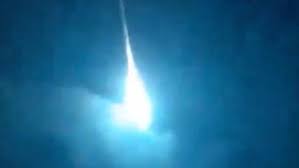A comet fragment sped over the atmosphere on Saturday night, providing skywatchers in Spain and Portugal with an incredible sight of light unlike anything they had ever seen. Many people were in a state of astonishment as they watched the stunning spectacle, which took place across both countries. Some even said it looked like something from a movie.
Immediately after, the European Space Agency (ESA) posted a video of the item speeding across the skies close to the western Spanish city of Caceres on social media. The video was taken by their “fireball camera”. After initially being referred to as a “stunning meteor,” the ESA subsequently explained that the flaming item was actually a comet fragment.
The comet fragment broke off and burned up completely over the Atlantic Ocean, leaving a bright path across the night sky at an estimated speed of 45 kilometers per second (28 miles per second). Although the picture was clearly amazing, the ESA played down the chance that any remaining debris would end up on Earth.
However, the occurrence caused a rush of activity on social media, with footage that were posted from different parts of Portugal and Spain becoming viral. Blues and greens dominated the display as the object descended quickly, dazzling the night sky in a multitude of vivid hues. Scientists think the fragment’s unearthly tint resulted from the magnesium it contained burning up in the Earth’s atmosphere.
The findings of the ESA were confirmed as coming from a comet by additional study conducted by the Spanish Calar Alto Astronomical Observatory and an initial investigation conducted by the Institute of Astrophysics in Andalusia. Unlike asteroids, comets are frozen space objects that round the Sun and frequently leave behind dusty trails. Unlike asteroids, which are usually stony in nature, they are composed of ice.
Astronomers were given a priceless opportunity for observation in addition to a spectacular light display by the unexpected guest from space. The scientific community is intrigued by the fragment’s peculiar track, which surpasses the average speed of most near-Earth objects. Its trajectory, according to experts, points to an origin that may be interstellar in nature, outside the typical monitoring range of asteroids.
Even while the fragment did not ultimately represent a threat, the incident serves as a reminder of the continual barrage that cosmic objects send towards our earth. Though smaller objects like this comet fragment can still evade detection, astronomers are continuously searching the skies for potentially dangerous asteroids. Events such as this underscore the significance of ongoing monitoring and space-based early warning systems in safeguarding our planet against potentially more severe repercussions in the future.




